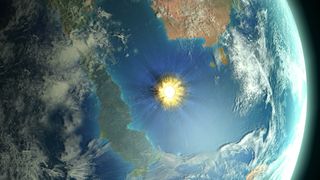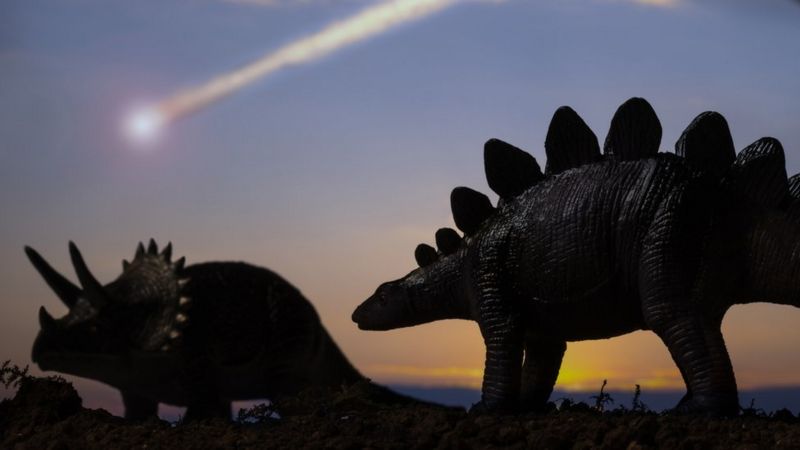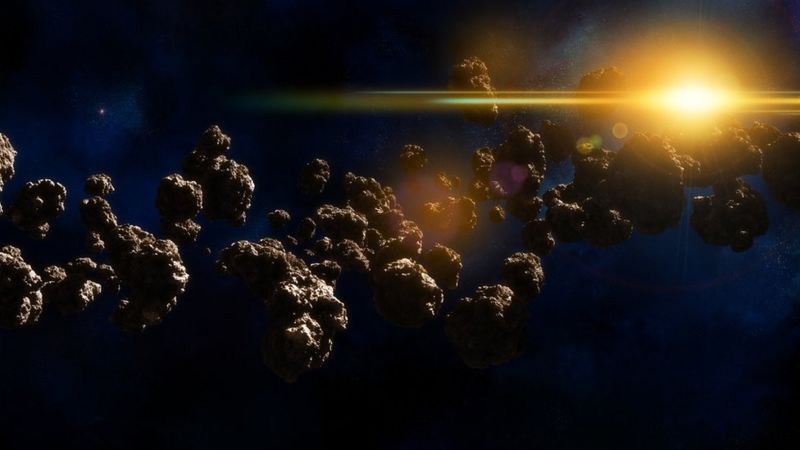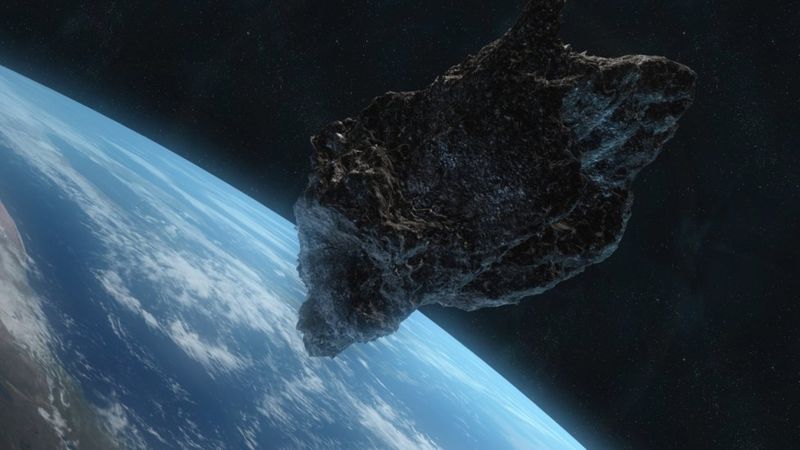By Ailsa Harvey
The impactor traveled further than previously predicted, before colliding with Earth.

A large asteroid caused the Cretaceous-Paleogene mass extinction.
(Image credit: Getty)
The asteroid credited with the extinction of the dinosaurs 66 million years ago is likely to have originated from the outer half of the solar system’s main asteroid belt, according to new research by Southwest Research Institute (SwRI)
Known as the Chicxulub impactor, this large object has an estimated width of 6 miles (9.6 kilometers) and produced a crater in Mexico’s Yucatan peninsula that spans 90 miles (145 kilometers). After its sudden contact with Earth, the asteroid wiped out not only the dinosaurs, but around 75 percent of the planet’s animal species. It is widely accepted that this explosive force created was responsible for the mass extinction that ended the Mesozoic era.
Researchers used computer models to analyse how asteroids are pulled from their orbit in different areas of the asteroid belt and drawn towards planets. The observations of 130,000 model asteroids, along with data and behaviour seen in other known impactors, found that objects are 10 times more likely to reach Earth from the outer asteroid belt than previously thought.
Prior to crashing into Earth, the extinction-causing asteroid orbited the sun with others, in the main asteroid belt. This concentrated band lies between planets Mars and Jupiter, with its contents usually kept in place by the forces of gravity. Before this study was released, scientists thought that very few of Earth’s impactors escaped from the belt’s outer half. But, researchers at SwRI discovered that “escape hatches” could be created by thermal forces, which pull more distant asteroids out of orbit and in the direction of Earth.
The objects found in these outermost parts of the asteroid belt include many carbonaceous chondrite impactors. These are dark, porous and carbon-containing rocks which can also be found on Earth. Leading up to this research, other scientists have attempted to learn more about the object that doomed the dinosaurs. This included examinations of 66-million-year-old rocks. By doing this, geologists discovered that the Chicxulub asteroid had a similar composition to today’s carbonaceous chondrites.
In the solar system, many objects surrounding Earth share similar composition to this impactor, however they are all much smaller, with widths around one mile. Researchers at SwRI used NASA’s Pleiades Supercomputer to analyse how asteroids furthest from the sun would have evolved over hundreds of millions of years. One aim was to see where the bigger asteroids lie today.
“To explain their absence, several past groups have simulated large asteroid and comet breakups in the inner solar system, looking at surges of impacts on Earth with the largest one producing Chicxulub crater,” one of the study’s researchers, Dr. William Bottke, said.
“While many of these models had interesting properties, none provided a satisfying match to what we know about asteroids and comets. It seemed like we were still missing something important.”
By looking at wide timescales of the Chicxulub asteroid, the scientists could predict that a 6-mile asteroid is likely to come into contact with Earth once every 250 million years. Their model showed almost 50 percent of these significant impactors to be of the same carbonaceous chondrite composition.
Details of the new study will be published in the November 2021 issue of the journal Icarus. One of its authors, Dr Simone Marchi, described the findings as “intriguing.”
“The team’s simulations can, for the first time, reproduce the orbits of large asteroids on the verge of approaching Earth,” said Marchi. “Our explanation for the source of the Chicxulub impactor fits in beautifully with what we already know about how asteroids evolve.”
According to co-author Dr. David Nesvorný, the new findings can teach us about other sizable asteroids. “This work will help us better understand the nature of the Chicxulub impact,” he said, “while also telling us where other large impactors from Earth’s deep past might have originated.”
Origin of dinosaur-ending asteroid possibly found. And it's dark.
By Mara Johnson-Groh
About 66 million years ago, an estimated 6-mile-wide (9.6 kilometers) object slammed into Earth, triggering a cataclysmic series of events that resulted in the demise of non-avian dinosaurs.
Now, scientists think they know where that object came from.
According to new research, the impact was caused by a giant dark primitive asteroid from the outer reaches of the solar system's main asteroid belt, situated between Mars and Jupiter. This region is home to many dark asteroids — space rocks with a chemical makeup that makes them appear darker (reflecting very little light) compared with other types of asteroids
Related: The 5 mass extinction events that shaped the history of Earth
"I had a suspicion that the outer half of the asteroid belt — that's where the dark primitive
asteroids are — may be an important source of terrestrial impactors," said David Nesvorný, a researcher from the Southwest Research Institute in Colorado, who led the new study. "But I did not expect that the results [would] be so definitive," adding that this might not be true for smaller impactors.
Clues about the object that ended the reign of non-avian dinosaurs have previously been found buried in the Chicxulub crater, a 90-mile-wide (145 km) circular scar in Mexico's Yucatan Peninsula left by the object's collision. Geochemical analysis of the crater has suggested that the impacting object was part of a class of carbonaceous chondrites — a primitive group of meteorites that have a relatively high ratio of carbon and were likely made very early on in the solar system's history.
Based on this knowledge, scientists have previously tried to pinpoint the impactor's origin, but many theories have crumbled over time. Researchers have previously suggested the impactor came from a family of asteroids from the inner part of the main asteroid belt, but follow-up observations of those asteroids found they didn't have the right composition. Another study, this one published in February in the journal Scientific Reports, suggested the impact was caused by a long-period comet, Live Science reported. But that research has since come under criticism, according to a June paper published in the journal Astronomy & Geophysics.
In the new study, published in the November 2021 issue of the journal Icarus, researchers developed a computer model to see how often main belt asteroids escape toward Earth and if such escapees could be responsible for the dinosaur-ending crash.
Simulating over hundreds of millions of years, the model showed thermal forces and gravitational tugs from planets periodically slingshotting large asteroids out of the belt. On average, an asteroid more than 6 miles wide from the outer edge of the belt was flung into a collision course with Earth once every 250 million years, the researchers found. This calculation makes such an event five times more common than previously thought and consistent with the Chicxulub crater created just 66 million years ago, which is the only known impact crater thought to have been produced by such a large asteroid in the last 250 million years. Furthermore, the model looked at the distribution of "dark" and "light" impactors in the asteroid belt and showed half of the expelled asteroids were the dark carbonaceous chondrites, which matches the type thought to have caused Chicxulub crater.
RELATED CONTENT
—Wipe out: History's 7 most mysterious extinctions
—Photos: A new look at T. rex and its relatives
—Dino graveyard: Photos of Dinosaur National Monument
"This is just an excellent paper," said Jessica Noviello, NASA fellow in the postdoctoral management program at the Universities Space Research Association at Goddard Space Flight Center, who was not involved with the new research. "I think they make a good argument for why [the Chicxulub impactor] could have come from that part of the solar system."
In addition to possibly explaining the origin of the Chicxulub crater impactor, the findings also help scientists understand the origins of other asteroids that have struck Earth further in the past. Neither of the other two largest impact craters on Earth, the Vredefort crater in South Africa and the Sudbury Basin in Canada, have known impactor origins. The results could also help scientists predict where future large impactors might originate..
"We find in the study that some 60% of large terrestrial impactors come from the outer half of the asteroid belt ... and most asteroids in that zone are dark/primitive," Nesvorný told Live Science. "So there is a 60% — 3 in 5 — probability that the next one will come from the same region."
Originally published on Live Science.
The asteroid credited with the extinction of the dinosaurs 66 million years ago is likely to have originated from the outer half of the solar system’s main asteroid belt, according to new research by Southwest Research Institute (SwRI)
Known as the Chicxulub impactor, this large object has an estimated width of 6 miles (9.6 kilometers) and produced a crater in Mexico’s Yucatan peninsula that spans 90 miles (145 kilometers). After its sudden contact with Earth, the asteroid wiped out not only the dinosaurs, but around 75 percent of the planet’s animal species. It is widely accepted that this explosive force created was responsible for the mass extinction that ended the Mesozoic era.
Researchers used computer models to analyse how asteroids are pulled from their orbit in different areas of the asteroid belt and drawn towards planets. The observations of 130,000 model asteroids, along with data and behaviour seen in other known impactors, found that objects are 10 times more likely to reach Earth from the outer asteroid belt than previously thought.
Prior to crashing into Earth, the extinction-causing asteroid orbited the sun with others, in the main asteroid belt. This concentrated band lies between planets Mars and Jupiter, with its contents usually kept in place by the forces of gravity. Before this study was released, scientists thought that very few of Earth’s impactors escaped from the belt’s outer half. But, researchers at SwRI discovered that “escape hatches” could be created by thermal forces, which pull more distant asteroids out of orbit and in the direction of Earth.
The objects found in these outermost parts of the asteroid belt include many carbonaceous chondrite impactors. These are dark, porous and carbon-containing rocks which can also be found on Earth. Leading up to this research, other scientists have attempted to learn more about the object that doomed the dinosaurs. This included examinations of 66-million-year-old rocks. By doing this, geologists discovered that the Chicxulub asteroid had a similar composition to today’s carbonaceous chondrites.
In the solar system, many objects surrounding Earth share similar composition to this impactor, however they are all much smaller, with widths around one mile. Researchers at SwRI used NASA’s Pleiades Supercomputer to analyse how asteroids furthest from the sun would have evolved over hundreds of millions of years. One aim was to see where the bigger asteroids lie today.
“To explain their absence, several past groups have simulated large asteroid and comet breakups in the inner solar system, looking at surges of impacts on Earth with the largest one producing Chicxulub crater,” one of the study’s researchers, Dr. William Bottke, said.
“While many of these models had interesting properties, none provided a satisfying match to what we know about asteroids and comets. It seemed like we were still missing something important.”
By looking at wide timescales of the Chicxulub asteroid, the scientists could predict that a 6-mile asteroid is likely to come into contact with Earth once every 250 million years. Their model showed almost 50 percent of these significant impactors to be of the same carbonaceous chondrite composition.
Details of the new study will be published in the November 2021 issue of the journal Icarus. One of its authors, Dr Simone Marchi, described the findings as “intriguing.”
“The team’s simulations can, for the first time, reproduce the orbits of large asteroids on the verge of approaching Earth,” said Marchi. “Our explanation for the source of the Chicxulub impactor fits in beautifully with what we already know about how asteroids evolve.”
According to co-author Dr. David Nesvorný, the new findings can teach us about other sizable asteroids. “This work will help us better understand the nature of the Chicxulub impact,” he said, “while also telling us where other large impactors from Earth’s deep past might have originated.”
Origin of dinosaur-ending asteroid possibly found. And it's dark.
By Mara Johnson-Groh
About 66 million years ago, an estimated 6-mile-wide (9.6 kilometers) object slammed into Earth, triggering a cataclysmic series of events that resulted in the demise of non-avian dinosaurs.
Now, scientists think they know where that object came from.
According to new research, the impact was caused by a giant dark primitive asteroid from the outer reaches of the solar system's main asteroid belt, situated between Mars and Jupiter. This region is home to many dark asteroids — space rocks with a chemical makeup that makes them appear darker (reflecting very little light) compared with other types of asteroids
Related: The 5 mass extinction events that shaped the history of Earth
"I had a suspicion that the outer half of the asteroid belt — that's where the dark primitive
asteroids are — may be an important source of terrestrial impactors," said David Nesvorný, a researcher from the Southwest Research Institute in Colorado, who led the new study. "But I did not expect that the results [would] be so definitive," adding that this might not be true for smaller impactors.
Clues about the object that ended the reign of non-avian dinosaurs have previously been found buried in the Chicxulub crater, a 90-mile-wide (145 km) circular scar in Mexico's Yucatan Peninsula left by the object's collision. Geochemical analysis of the crater has suggested that the impacting object was part of a class of carbonaceous chondrites — a primitive group of meteorites that have a relatively high ratio of carbon and were likely made very early on in the solar system's history.
Based on this knowledge, scientists have previously tried to pinpoint the impactor's origin, but many theories have crumbled over time. Researchers have previously suggested the impactor came from a family of asteroids from the inner part of the main asteroid belt, but follow-up observations of those asteroids found they didn't have the right composition. Another study, this one published in February in the journal Scientific Reports, suggested the impact was caused by a long-period comet, Live Science reported. But that research has since come under criticism, according to a June paper published in the journal Astronomy & Geophysics.
In the new study, published in the November 2021 issue of the journal Icarus, researchers developed a computer model to see how often main belt asteroids escape toward Earth and if such escapees could be responsible for the dinosaur-ending crash.
Simulating over hundreds of millions of years, the model showed thermal forces and gravitational tugs from planets periodically slingshotting large asteroids out of the belt. On average, an asteroid more than 6 miles wide from the outer edge of the belt was flung into a collision course with Earth once every 250 million years, the researchers found. This calculation makes such an event five times more common than previously thought and consistent with the Chicxulub crater created just 66 million years ago, which is the only known impact crater thought to have been produced by such a large asteroid in the last 250 million years. Furthermore, the model looked at the distribution of "dark" and "light" impactors in the asteroid belt and showed half of the expelled asteroids were the dark carbonaceous chondrites, which matches the type thought to have caused Chicxulub crater.
RELATED CONTENT
—Wipe out: History's 7 most mysterious extinctions
—Photos: A new look at T. rex and its relatives
—Dino graveyard: Photos of Dinosaur National Monument
"This is just an excellent paper," said Jessica Noviello, NASA fellow in the postdoctoral management program at the Universities Space Research Association at Goddard Space Flight Center, who was not involved with the new research. "I think they make a good argument for why [the Chicxulub impactor] could have come from that part of the solar system."
In addition to possibly explaining the origin of the Chicxulub crater impactor, the findings also help scientists understand the origins of other asteroids that have struck Earth further in the past. Neither of the other two largest impact craters on Earth, the Vredefort crater in South Africa and the Sudbury Basin in Canada, have known impactor origins. The results could also help scientists predict where future large impactors might originate..
"We find in the study that some 60% of large terrestrial impactors come from the outer half of the asteroid belt ... and most asteroids in that zone are dark/primitive," Nesvorný told Live Science. "So there is a 60% — 3 in 5 — probability that the next one will come from the same region."
Originally published on Live Science.
Where did the asteroid that wiped out dinosaurs come from?
20 Aug 2021

GETTY IMAGES
Scientists have worked out where the asteroid that wiped out the dinosaurs and most of life on Earth came from.
This asteroid is officially known as the Chicxulub impactor and smashed into the planet 66 million years ago.
The space rock itself was six miles wide, but it hit the surface of the Earth with so much force that it left a crater that is 90-miles wide. Today the impact crater is buried underneath the Yucatán Peninsula on the coast of Mexico.
Scientists have been trying to work out the origin of this asteroid for several years, but a new study by the Southwest Research Institute based in Texas suggests that the dinosaur-destroying rock came from the outer half of the asteroid belt in our own solar system.
More space stories like this:
Car-sized asteroid has near-miss with Earth!
Asteroid 'definitely' caused dinosaur extinction say scientists
Nasa captures rare moment comet shatters into pieces
The asteroid belt

Scientists have worked out where the asteroid that wiped out the dinosaurs and most of life on Earth came from.
This asteroid is officially known as the Chicxulub impactor and smashed into the planet 66 million years ago.
The space rock itself was six miles wide, but it hit the surface of the Earth with so much force that it left a crater that is 90-miles wide. Today the impact crater is buried underneath the Yucatán Peninsula on the coast of Mexico.
Scientists have been trying to work out the origin of this asteroid for several years, but a new study by the Southwest Research Institute based in Texas suggests that the dinosaur-destroying rock came from the outer half of the asteroid belt in our own solar system.
More space stories like this:
Car-sized asteroid has near-miss with Earth!
Asteroid 'definitely' caused dinosaur extinction say scientists
Nasa captures rare moment comet shatters into pieces
The asteroid belt

GETTY IMAGES
The asteroid belt is located between Mars and Jupiter and is the left over bits of rock from when the planets in our solar system formed over four billion years ago.
Scientists used computer models to analyse how asteroids in that region of space are pulled from their orbit around the sun into different parts of the solar system.
It included a number of factors such as bumping into other asteroids, getting knocked out of the belt and into space.
The team also discovered "escape hatches", which are essentially where an asteroid can move out of the belt over time. Radiation in space can nudge the position of asteroids and eventually, combined with the gravitational pull of planets, the asteroids can slip out of the belt and into space, moving toward Earth or anywhere else really.
What is radiation?
Radiation is energy that moves from one thing to another.
What's the connection?
So how did the team connect the dinosaur-destroying asteroid with those found in the asteroid belt? Well, the scientists examined what the asteroids are made of.
"We decided to look for where the siblings of the Chicxulub impactor might be hiding," said David Nesvorný, lead author of the research.

The asteroid belt is located between Mars and Jupiter and is the left over bits of rock from when the planets in our solar system formed over four billion years ago.
Scientists used computer models to analyse how asteroids in that region of space are pulled from their orbit around the sun into different parts of the solar system.
It included a number of factors such as bumping into other asteroids, getting knocked out of the belt and into space.
The team also discovered "escape hatches", which are essentially where an asteroid can move out of the belt over time. Radiation in space can nudge the position of asteroids and eventually, combined with the gravitational pull of planets, the asteroids can slip out of the belt and into space, moving toward Earth or anywhere else really.
What is radiation?
Radiation is energy that moves from one thing to another.
What's the connection?
So how did the team connect the dinosaur-destroying asteroid with those found in the asteroid belt? Well, the scientists examined what the asteroids are made of.
"We decided to look for where the siblings of the Chicxulub impactor might be hiding," said David Nesvorný, lead author of the research.

GETTY IMAGES
By analysing 66-million-year-old rocks on Earth, the team worked out that the Chicxulub impactor asteroid had a similar make-up to space rock called "carbonaceous chondrite impactors" found in the asteroid belt.
Carbonaceous chondrite impactors contain carbon in the form of graphite - that's the same stuff that's inside your school pencils!
So could this happen again?
To enjoy the CBBC Newsround website at its best you will need to have JavaScript turned on.
WATCH: How Nasa plans to stop asteroids hitting Earth in the future (2017)
The short answer is yes - but you don't need to worry!
The team tracked 130,000 asteroids in the belt between Mars and Jupiter. They discovered that similar rocks to the one that caused the dinosaurs' extinction were hard to find, and were generally much smaller. The biggest was about one mile in length.
However, the research did reveal that bigger asteroids were at least 10 times more likely to hit the Earth than previously thought.
But, any collision with large asteroids will happen once every 250 million years or so on average, so there's still another 184 million years to go until another asteroid similar to the one that wiped out the dinosaurs heads for our planet.
By analysing 66-million-year-old rocks on Earth, the team worked out that the Chicxulub impactor asteroid had a similar make-up to space rock called "carbonaceous chondrite impactors" found in the asteroid belt.
Carbonaceous chondrite impactors contain carbon in the form of graphite - that's the same stuff that's inside your school pencils!
So could this happen again?
To enjoy the CBBC Newsround website at its best you will need to have JavaScript turned on.
WATCH: How Nasa plans to stop asteroids hitting Earth in the future (2017)
The short answer is yes - but you don't need to worry!
The team tracked 130,000 asteroids in the belt between Mars and Jupiter. They discovered that similar rocks to the one that caused the dinosaurs' extinction were hard to find, and were generally much smaller. The biggest was about one mile in length.
However, the research did reveal that bigger asteroids were at least 10 times more likely to hit the Earth than previously thought.
But, any collision with large asteroids will happen once every 250 million years or so on average, so there's still another 184 million years to go until another asteroid similar to the one that wiped out the dinosaurs heads for our planet.
No comments:
Post a Comment